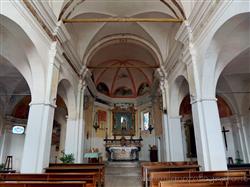|
Sandigliano (Biella)- Church of Santa Maria delle Grazie del Barazzone
|
|
|
Show to visit in the Biella area: |
 The Church of Saint Mary of Graces of the Barazzone ("Santa Maria delle Grazie del Barazzone"), otherwise also known as the Church of Our Lady of Loreto or simply Church of the Barazzone, is located just outside the town, on the road to Candelo. The Church of Saint Mary of Graces of the Barazzone ("Santa Maria delle Grazie del Barazzone"), otherwise also known as the Church of Our Lady of Loreto or simply Church of the Barazzone, is located just outside the town, on the road to Candelo.
It is the result of a seventeenth-century extension of a smaller sixteenth-century original church which is thought have coincided with the left aisle.
The current building is entirely in exposed brick, with an asymmetrical body due to valumes added above the lateral naves, so that the right side is higher than the left one. The façade, in Baroque style and vertically marked by pilasters, in fact appears undersized compared to the body of the church, given that this protrudes above the two curved sails of the façade.
With two orders separated with a certain refinement by a classicizing entablature, the facade is enriched in the lower order by a small portico in front of the entrance and in the upper order by a serliana flanked by two empty niches. At the top there is a large pediment.
At the bottom of the right side of the church there is a bell tower divided into six levels, with the two upper ones having two windows on each side.
To the right of the church, approximately in line with the facade, there is a stone column with an iron cross at the apex. It was built in 1726.
The interior of the church is made bright both by the various windows on the facade and by the white plaster that covers most of the surfaces. The three naves are separated by large pillars endowed on the face facing the central nave with a pilaster that rises up to the thick entablature between walls and ceiling.
All the ceilings of the naves consist of cross vaults.
The church has a single side chapel, located at the bottom of the left aisle starting from the entrance and dedicated to San Rocco.
Furthermore there are the two side apses, rather refined in their structure, with an elaborate entablature between walls and vaults and stucco cornices to delimit the lunettes. The one on the left is thought to coincide with the apse of the small original Renaissance church. On the back wall there is a fresco of the Nativity attributed to the workshop of Daniele de Bosis (a fresco therefore from the first part of the sixteenth century) and once venerated as it was considered miraculous. The fresco is framed by a seventeenth-century painted wooden frame open on the lower side and bearing ex voto painted in rounds. It is assumed that this frame was the retable of the altar of the original church.
The right lateral apse instead houses a very ruined painting of a Madonna in glory surrounded by angels in the background of what could be the Sacred Mountain of Oropa. It is located within a rich frame of carved and gilded wood.
The main apse is very deep as the polygonal back side is preceded by a rectangular area and is even more elaborate than the lateral ones, with the continuation of the entablature present in the main nave between walls and vault and pilasters at the corners of the rear part.
The altar in polychrome marble was built in 1784. On the back wall there is a valuable retable in carved and gilded wood decorated with floral motifs and cherub heads, in the center of which there is a niche with a statue of the Virgin inside.
On the counter-façade, finally, there is a choir with a curved balustrade decorated with plant and floral elements in the Baroque style.
Categories: Places of historical value of artistic value
Via Dante Alighieri, 11, 13876 Madonnina BI |
Church of Santa Maria delle Grazie del Barazzone: Further pictures in the section Photography |